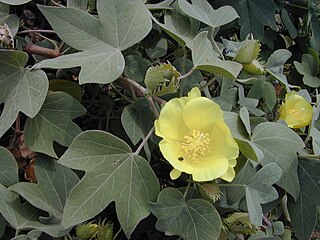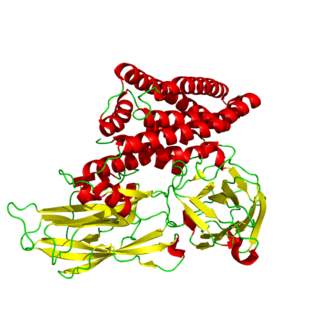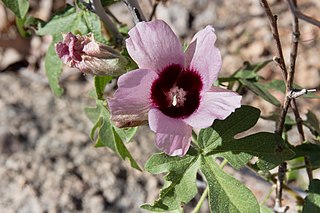
Cotton is a soft, fluffy staple fiber that grows in a boll, or protective case, around the seeds of the cotton plants of the genus Gossypium in the mallow family Malvaceae. The fiber is almost pure cellulose, and can contain minor percentages of waxes, fats, pectins, and water. Under natural conditions, the cotton bolls will increase the dispersal of the seeds.

Gossypium is a genus of flowering plants in the tribe Gossypieae of the mallow family, Malvaceae, from which cotton is harvested. It is native to tropical and subtropical regions of the Old and New Worlds. There are about 50 Gossypium species, making it the largest genus in the tribe Gossypieae, and new species continue to be discovered. The name of the genus is derived from the Arabic word goz, which refers to a soft substance.

Selective breeding is the process by which humans use animal breeding and plant breeding to selectively develop particular phenotypic traits (characteristics) by choosing which typically animal or plant males and females will sexually reproduce and have offspring together. Domesticated animals are known as breeds, normally bred by a professional breeder, while domesticated plants are known as varieties, cultigens, cultivars, or breeds. Two purebred animals of different breeds produce a crossbreed, and crossbred plants are called hybrids. Flowers, vegetables and fruit-trees may be bred by amateurs and commercial or non-commercial professionals: major crops are usually the provenance of the professionals.
A transgene is a gene that has been transferred naturally, or by any of a number of genetic engineering techniques, from one organism to another. The introduction of a transgene, in a process known as transgenesis, has the potential to change the phenotype of an organism. Transgene describes a segment of DNA containing a gene sequence that has been isolated from one organism and is introduced into a different organism. This non-native segment of DNA may either retain the ability to produce RNA or protein in the transgenic organism or alter the normal function of the transgenic organism's genetic code. In general, the DNA is incorporated into the organism's germ line. For example, in higher vertebrates this can be accomplished by injecting the foreign DNA into the nucleus of a fertilized ovum. This technique is routinely used to introduce human disease genes or other genes of interest into strains of laboratory mice to study the function or pathology involved with that particular gene.

Gossypium barbadense is one of several species of cotton. It is in the mallow family. It has been cultivated since antiquity, but has been especially prized since a form with particularly long fibers was developed in the 19th century. Other names associated with this species include Sea Island, Egyptian, Pima, and extra-long staple (ELS) cotton.

Gossypium hirsutum, also known as upland cotton or Mexican cotton, is the most widely planted species of cotton in the world. Globally, about 90% of all cotton production is of cultivars derived from this species. In the United States, the world's largest exporter of cotton, it constitutes approximately 95% of all cotton production. It is native to Mexico, the West Indies, northern South America, Central America and possibly tropical Florida.

Gossypium tomentosum, commonly known as maʻo, huluhulu or Hawaiian cotton, is a species of cotton plant that is endemic to the Hawaiian Islands. It inhabits low shrublands at elevations from sea level to 120 m (390 ft). Maʻo is a shrub that reaches a height of 1.5–5 ft (0.46–1.52 m) and a diameter of 5–10 ft (1.5–3.0 m). The seed hairs (lint) are short and reddish brown, unsuitable for spinning or twisting into thread.

Gossypium herbaceum, commonly known as Levant cotton, is a species of cotton native to the semi-arid regions of sub-Saharan Africa and Arabia, where it still grows perennially in the wild as a shrub.
Meloidogyne acronea, the African cotton root-knot nematode or African cotton root nematode, is a plant pathogenic nematode affecting pigeonpeas. It is also an invasive species. The roots and surrounding soils of cereals, grasses, and Gossypium spp. provide habitat for this organism. M. acronea was confirmed as a potentially problematic pest of cotton, Gossypium hirsutum cv. Makoka, which was proven through pot experiments.

Sir Joseph Burtt Hutchinson FRS was a British biologist. He was Drapers Professor of Agriculture at the University of Cambridge from 1957-1969.
G. darwinii may refer to:
Reciprocal silencing, a genetic phenomenon that primarily occurs in plants, refers to the pattern of redundant genes being silenced following a polyploid event. Polyploidy is common in plants and constitutes an important method of speciation. When a polyploid species arises, its genome contains homoeologs, duplicated chromosomes with equivalent genetic information. However silencing of redundant genes occurs rapidly in new polyploids through genetic and epigenetic means. This primarily occurs because redundancy allows one of the two genes present for each locus to be silenced without affecting the phenotype of the organism, and thus mutations that eliminate gene expression are much less likely to be deleterious or lethal. This allows mutations that would be lethal in diploid populations to accumulate in polyploids. Reciprocal silencing refers to the specific pattern of silencing where equivalent loci in are both silenced and expressed in a reciprocal manner. This phenomenon is observed on two distinct scales.

Cry1Ac protoxin is a crystal protein produced by the gram-positive bacterium, Bacillus thuringiensis (Bt) during sporulation. Cry1Ac is one of the delta endotoxins produced by this bacterium which act as insecticides. Because of this, the genes for these have been introduced into commercially important crops by genetic engineering in order to confer pest resistance on those plants.

Liam Dolan is a Senior Group Leader at the Gregor Mendel Institute of Molecular Plant Biology (GMI) of the Austrian Academy of Sciences, the Sherardian Professor of Botany in the Department of Biology at the University of Oxford and a Fellow of Magdalen College, Oxford.

Cotton production in China pertains to cotton which is the prime cash crop of China. Its production was the highest in the world from 1982 until being overtaken by India. Twenty-four of the 35 provinces of China grow cotton, with nearly 300 million people involved in its production. It is the main input for textile industry of the country with cotton textiles now accounting for 80% use vis-à-vis 95% in the 1950s. The cotton textile industry employs over 10 million people. Its production in 2012–13 was 7.6 million tons, but in 2013–14 it dropped to 7 million tons. Historically, its introduction in China is considered a 'southernization', a crop which originated from southern Asia (India) during the "proto-globalization" period.

Creontiades dilutus, commonly known as the green mirid, is a member of the bug family Miridae. This insect is considered a "generalist" feeding on over 100 plant species, and is also a major economic pest on several important agricultural crops.

The scientific study of speciation — how species evolve to become new species — began around the time of Charles Darwin in the middle of the 19th century. Many naturalists at the time recognized the relationship between biogeography and the evolution of species. The 20th century saw the growth of the field of speciation, with major contributors such as Ernst Mayr researching and documenting species' geographic patterns and relationships. The field grew in prominence with the modern evolutionary synthesis in the early part of that century. Since then, research on speciation has expanded immensely.
Amanda M. Hulse-Kemp is a computational biologist with the United States Department of Agriculture – Agricultural Research Service. She works in the Genomics and Bioinformatics Research Unit and is stationed on the North Carolina State University campus in Raleigh, North Carolina.

A mixed mating system, also known as “variable inbreeding” a characteristic of many hermaphroditic seed plants, where more than one means of mating is used. Mixed mating usually refers to the production of a mixture of self-fertilized (selfed) and outbred (outcrossed) seeds. Plant mating systems influence the distribution of genetic variation within and among populations, by affecting the propensity of individuals to self-fertilize or cross-fertilize . Mixed mating systems are generally characterized by the frequency of selfing vs. outcrossing, but may include the production of asexual seeds through agamospermy. The trade offs for each strategy depend on ecological conditions, pollinator abundance and herbivory and parasite load. Mating systems are not permanent within species; they can vary with environmental factors, and through domestication when plants are bred for commercial agriculture.

Gossypium anomalum is a species of wild cotton in the family Malvaceae, native to drier parts of Africa. A crop wild relative of cultivated cotton, its genome has been sequenced.















